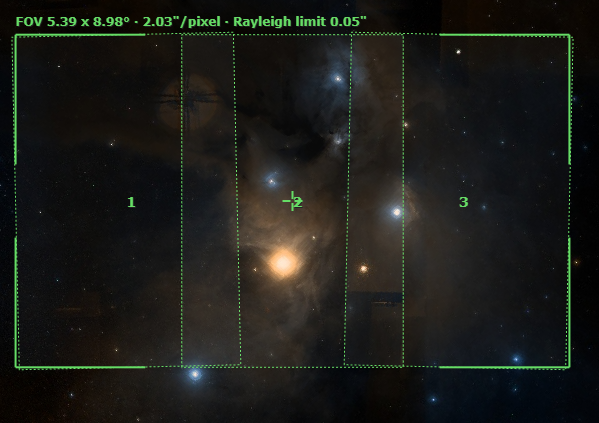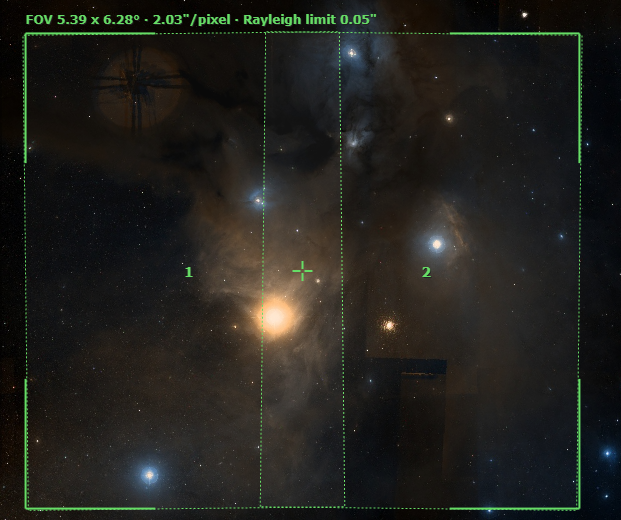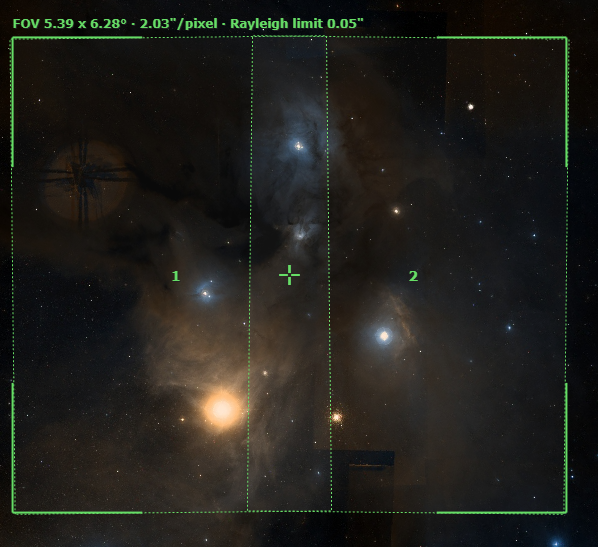In a month or two and weather depending, this area just about rises high enough to allow a bit of imaging time east and west of the meridian. As it is can only be done for a short time each year and when the moon is out of the way, Steve's recommendation to do a large mosaic gets my vote. A lot of good stuff in that region.
Steve mentioned doing a 4 panel to allow for overlapping and field curvature which is a good point. The number of panels will depend on how much we want to capture. I don't have access to any really good aids to map out a decent mosaic, but I can start us off with a 3 panel suggestion that would accommodate most of the best bits. This could however fail in 2 ways. Firstly by not encompassing something someone else would like including, and secondly, one or more of the choice objects may fall too close to an edge. I have allowed a reasonable amount of overlap.
Suggestion -
Three vertically aligned overlapping panels. The common declination around - 25° 20' Permission has been granted by Steve to go below the recommended limit.
Panels centred on RA: 16h 44m, 16h 33m, 16h 22m from east to west.
I don't have any software to be able to visualise this and is just a starting point to work off. If we need 4 panels that's fine, and regardless please adjust accordingly in both DEC and RA if it needs tweaking.
Strangely enough both Steve and I came up with the same name when it comes to doing a really good job with these mosaics.
Steve mentioned doing a 4 panel to allow for overlapping and field curvature which is a good point. The number of panels will depend on how much we want to capture. I don't have access to any really good aids to map out a decent mosaic, but I can start us off with a 3 panel suggestion that would accommodate most of the best bits. This could however fail in 2 ways. Firstly by not encompassing something someone else would like including, and secondly, one or more of the choice objects may fall too close to an edge. I have allowed a reasonable amount of overlap.
Suggestion -
Three vertically aligned overlapping panels. The common declination around - 25° 20' Permission has been granted by Steve to go below the recommended limit.
Panels centred on RA: 16h 44m, 16h 33m, 16h 22m from east to west.
I don't have any software to be able to visualise this and is just a starting point to work off. If we need 4 panels that's fine, and regardless please adjust accordingly in both DEC and RA if it needs tweaking.
Strangely enough both Steve and I came up with the same name when it comes to doing a really good job with these mosaics.
Ray
Roboscopes Guinea Pig
0
I think you must need really Old Eyes and experience to do decent mosaics, my youthful persona is not up to the task 
Please ignore my dylexia wherever possible, just be thankful I can control my Tourettes ;)
Things to do, so little time!
Steve
Roboscopes Tea Boy
Ray,
I tried your coordinates in Telescopius and got roughly this FOV:

If that is what you had in mind, the coordinates for each pane were:
Pane, RA, DEC, Position Angle (East), Pane width (arcmins), Pane height (arcmins), Overlap, Row, Column
Pane 1, 16hr 40' 40", -25º 23' 27", 88.72, 323.40, 215.40, 25%, 1, 1
Pane 2, 16hr 28' 44", -25º 25' 16", 90.00, 323.40, 215.40, 25%, 2, 1
Pane 3, 16hr 16' 49", -25º 23' 27", 91.28, 323.40, 215.40, 25%, 3, 1
Since we are short of time on this target, it might be a good idea to go for pane 2 first, as this will be a nice image in its own right.
I tried your coordinates in Telescopius and got roughly this FOV:
If that is what you had in mind, the coordinates for each pane were:
Pane, RA, DEC, Position Angle (East), Pane width (arcmins), Pane height (arcmins), Overlap, Row, Column
Pane 1, 16hr 40' 40", -25º 23' 27", 88.72, 323.40, 215.40, 25%, 1, 1
Pane 2, 16hr 28' 44", -25º 25' 16", 90.00, 323.40, 215.40, 25%, 2, 1
Pane 3, 16hr 16' 49", -25º 23' 27", 91.28, 323.40, 215.40, 25%, 3, 1
Since we are short of time on this target, it might be a good idea to go for pane 2 first, as this will be a nice image in its own right.
Attachments (1)
Richard,
What a star! That's a great illustration and if we go for 3 panels that's what we should go for. With regards to limited imaging time I would also err on the side of caution. I imagine a 2 pane would require the 2 outer ones moving in towards the centre with adjusted coordinates. Now if Steve reckons there would be time, we then may need to rethink that. I'd rather be cautious, not that I don't trust Steve, it's the weather gods I don't.
I haven't given any thought yet to exposure times, but I'll look at some examples online. If you already have suggestions then that would be a great help.
Thanks again Richard. Just need some decent skies now and then the exciting bit starts when we start getting the data back.
Best regards,
Ray
What a star! That's a great illustration and if we go for 3 panels that's what we should go for. With regards to limited imaging time I would also err on the side of caution. I imagine a 2 pane would require the 2 outer ones moving in towards the centre with adjusted coordinates. Now if Steve reckons there would be time, we then may need to rethink that. I'd rather be cautious, not that I don't trust Steve, it's the weather gods I don't.
I haven't given any thought yet to exposure times, but I'll look at some examples online. If you already have suggestions then that would be a great help.
Thanks again Richard. Just need some decent skies now and then the exciting bit starts when we start getting the data back.
Best regards,
Ray
Ray
Roboscopes Guinea Pig
Ray,
So a two-pane mosaic could cover this FOV:

Coordinates:
Pane, RA, DEC, Position Angle (East), Pane width (arcmins), Pane height (arcmins), Overlap, Row, Column
Center, 16hr 28' 00", -25º 54' 39", 90.00, 323.40, 215.40, 25%, -, -
Pane 1, 16hr 33' 59", -25º 54' 11", 89.35, 323.40, 215.40, 25%, 1, 1
Pane 2, 16hr 22' 01", -25º 54' 11", 90.65, 323.40, 215.40, 25%, 2, 1
I am always looking for the fallback position that says - "what if we only get time for one panel?".
In this case, the left -hand panel would look good on its own as the main Antares nebula is sufficiently far away from the edge. You also have IC4605 and NGC 6144 in the frame along with a lot of nebulosity. The second frame extends the nebulosity and brings in the rho-Oph nebula, IC 4604. Crab globuiar cluster and lots more attractive nebulosity.
An alternative framing chops of the bottom of the Antares Nebula in favour of a better view of rho-Oph.

Pane, RA, DEC, Position Angle (East), Pane width (arcmins), Pane height (arcmins), Overlap, Row, Column
Center, 16hr 26' 00", -24º 54' 23", 90.00, 323.40, 215.40, 25%, -, -
Pane 1, 16hr 31' 56", -24º 53' 57", 89.38, 323.40, 215.40, 25%, 1, 1
Pane 2, 16hr 20' 03", -24º 53' 57", 90.62, 323.40, 215.40, 25%, 2, 1
I prefer this version, although it is not such a good view of the Antares Nebula. Both panels are good on their own.
So a two-pane mosaic could cover this FOV:
Coordinates:
Pane, RA, DEC, Position Angle (East), Pane width (arcmins), Pane height (arcmins), Overlap, Row, Column
Center, 16hr 28' 00", -25º 54' 39", 90.00, 323.40, 215.40, 25%, -, -
Pane 1, 16hr 33' 59", -25º 54' 11", 89.35, 323.40, 215.40, 25%, 1, 1
Pane 2, 16hr 22' 01", -25º 54' 11", 90.65, 323.40, 215.40, 25%, 2, 1
I am always looking for the fallback position that says - "what if we only get time for one panel?".
In this case, the left -hand panel would look good on its own as the main Antares nebula is sufficiently far away from the edge. You also have IC4605 and NGC 6144 in the frame along with a lot of nebulosity. The second frame extends the nebulosity and brings in the rho-Oph nebula, IC 4604. Crab globuiar cluster and lots more attractive nebulosity.
An alternative framing chops of the bottom of the Antares Nebula in favour of a better view of rho-Oph.
Pane, RA, DEC, Position Angle (East), Pane width (arcmins), Pane height (arcmins), Overlap, Row, Column
Center, 16hr 26' 00", -24º 54' 23", 90.00, 323.40, 215.40, 25%, -, -
Pane 1, 16hr 31' 56", -24º 53' 57", 89.38, 323.40, 215.40, 25%, 1, 1
Pane 2, 16hr 20' 03", -24º 53' 57", 90.62, 323.40, 215.40, 25%, 2, 1
I prefer this version, although it is not such a good view of the Antares Nebula. Both panels are good on their own.
Attachments (2)
Richard that's great, you've covered all the bases there. I agree with the second option, imaging pane 1 first.
I have found something interesting and useful in Astrobin. If you type this into your browser hopefully it will link you to an image of this region.
Rho ophiuchi complex nicolas rolland
This was taken from Oz at a remote site operated by Martin Pugh. His setup uses the FSQ106 but at its native focal length of 530mm. Coincidentally it usefully has a similar camera made by QHY with the same 61mp sensor.
The image consists of 3 x 15 minutes exposures each in RGB, no Luminance. While we have an imposed limit of 300s these were taken at 3 times the length. I believe this is mainly down to the slower focal ratio, F5 vs F3. 6, and being imaged at a darker site. This is a single image, dimensions 230 x 153 arc minutes, centred at 16h 28m 17s and - 24d 42m 56s. Pane 1 has very close coordinates to that.
To estimate the integration time to approximately reproduce that image on our pier, I used the U235 app with assistance from Brian who wrote it, and have come up with the following data.
I have carried out the calculations using 240sec and 300sec.
Number of exposures per filter using 240sec exposures. I've included luminance even though that image does not.
Lum: 6
Red: 10
Grn: 8
Blu: 10
Total 136 minutes
Using 300sec exposures.
Lum: 5
Red: 8
Grn: 6
Blu: 8
Total 135 minutes
I'd be happy to add a few more to each of those numbers to allow for the different locations being imaged from and possible less than ideal sky conditions at the time.
All comments and questions welcomed.
I have found something interesting and useful in Astrobin. If you type this into your browser hopefully it will link you to an image of this region.
Rho ophiuchi complex nicolas rolland
This was taken from Oz at a remote site operated by Martin Pugh. His setup uses the FSQ106 but at its native focal length of 530mm. Coincidentally it usefully has a similar camera made by QHY with the same 61mp sensor.
The image consists of 3 x 15 minutes exposures each in RGB, no Luminance. While we have an imposed limit of 300s these were taken at 3 times the length. I believe this is mainly down to the slower focal ratio, F5 vs F3. 6, and being imaged at a darker site. This is a single image, dimensions 230 x 153 arc minutes, centred at 16h 28m 17s and - 24d 42m 56s. Pane 1 has very close coordinates to that.
To estimate the integration time to approximately reproduce that image on our pier, I used the U235 app with assistance from Brian who wrote it, and have come up with the following data.
I have carried out the calculations using 240sec and 300sec.
Number of exposures per filter using 240sec exposures. I've included luminance even though that image does not.
Lum: 6
Red: 10
Grn: 8
Blu: 10
Total 136 minutes
Using 300sec exposures.
Lum: 5
Red: 8
Grn: 6
Blu: 8
Total 135 minutes
I'd be happy to add a few more to each of those numbers to allow for the different locations being imaged from and possible less than ideal sky conditions at the time.
All comments and questions welcomed.
Ray
Roboscopes Guinea Pig
This was taken from Oz at a remote site operated by Martin Pugh. His setup uses the FSQ106 but at its native focal length of 530mm. Coincidentally it usefully has a similar camera made by QHY with the same 61mp sensor.
The image consists of 3 x 15 minutes exposures each in RGB, no Luminance. While we have an imposed limit of 300s these were taken at 3 times the length. I believe this is mainly down to the slower focal ratio, F5 vs F3. 6, and being imaged at a darker site. This is a single image, dimensions 230 x 153 arc minutes, centred at 16h 28m 17s and - 24d 42m 56s. Pane 1 has very close coordinates to that.
Yes, P14 is a single F stop quicker so in reality a single 300s sub is like 600s at F5, also it depends how you set the gain as CMOS can be tuned for longer or shorter subs depending upon the chosen gain setting, quite flexible really
The final factor on top of this for us is not guiding as unguided imaging is the most productive way of imaging time wise, compared to finding a guide star, settling times etc etc
Its just point, solve, repoint and shoot
Option 2 looked good to me also but as they say its your party, I do think you are early enough in the year to not have to worry about which one gets doen first however as its a summer object which is part of the super long Spanish clear sky spell fover the spring summer period
HTH
Steve
Please ignore my dylexia wherever possible, just be thankful I can control my Tourettes ;)
Things to do, so little time!
Steve
Roboscopes Tea Boy
Hi Richard,
You could be right about the Ha but a fair majority of the images I looked at on Astrobin and Telescopius were taken using camera lenses and either DSLR, CSC or OSC cameras. The image posted by Peter on this forum was one, Sigma lens and OSC. I cannot say for sure though that there weren't any using Ha. My only concern would be the additional imaging time required for an unknown. Perhaps after capturing what we need we could then do a test run.
If you like I'll book your second suggestion, frame 1 then frame 2.
Cheers,
Ray
You could be right about the Ha but a fair majority of the images I looked at on Astrobin and Telescopius were taken using camera lenses and either DSLR, CSC or OSC cameras. The image posted by Peter on this forum was one, Sigma lens and OSC. I cannot say for sure though that there weren't any using Ha. My only concern would be the additional imaging time required for an unknown. Perhaps after capturing what we need we could then do a test run.
If you like I'll book your second suggestion, frame 1 then frame 2.
Cheers,
Ray
Ray
Roboscopes Guinea Pig
Confession time.
I made a glaring blunder using the exposure calculation app. When updating my project using the surface brightness Brian supplied me with, I didn't delete the project before recalculating. This resulted in over optimistic numbers.
After correcting my mistake the new numbers are below. All are for 300s exposures.
Lum: 15
Red: 16
Grn: 13
Blu: 16
The large increase in the number of Luminance frames helps boost the overall SNR. I'm still waiting though to hear back from Brian as to his thoughts on that image by Nicolas using just 3 frames on each filter. The original numbers I quoted should have matched his image.
I made a glaring blunder using the exposure calculation app. When updating my project using the surface brightness Brian supplied me with, I didn't delete the project before recalculating. This resulted in over optimistic numbers.
After correcting my mistake the new numbers are below. All are for 300s exposures.
Lum: 15
Red: 16
Grn: 13
Blu: 16
The large increase in the number of Luminance frames helps boost the overall SNR. I'm still waiting though to hear back from Brian as to his thoughts on that image by Nicolas using just 3 frames on each filter. The original numbers I quoted should have matched his image.
Ray
Roboscopes Guinea Pig
- Page :
- 1
There are no replies made for this post yet.
Be one of the first to reply to this post!
Be one of the first to reply to this post!
Please login to post a reply
You will need to be logged in to be able to post a reply. Login using the form on the right or register an account if you are new here. Register Here »
This website uses cookies to manage authentication, navigation, and other functions. By using our website, you agree that we can place these types of cookies on your device.
You have declined cookies. This decision can be reversed.
Proud to use
-
FLI
-
656 Imaging
-
10 Micron
-
Planewave
-
ZWO
Resources
Company Details:
Roboscopes
802 Kingsbury Road
Birmingham
B24 9PS
United Kingdom








